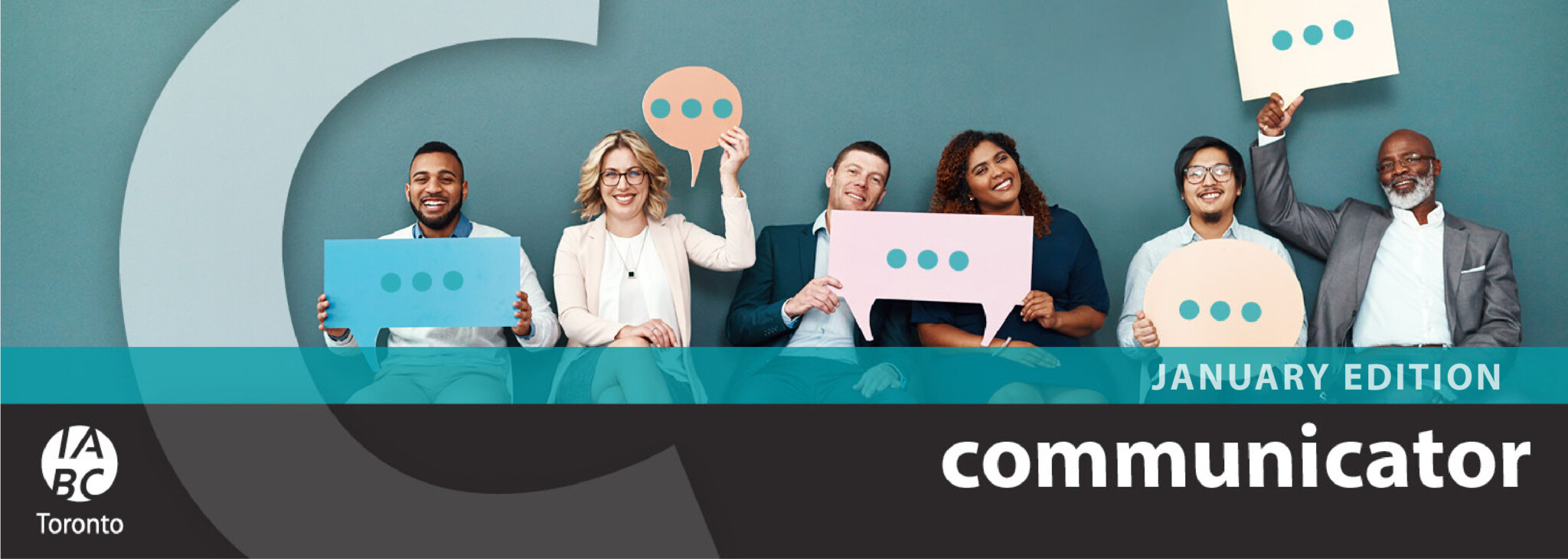By Amanda Cosentino
Amanda Cosentino poses the question: When you think about the word “accessibility,” what images pop up in your head?

When you think about the word “accessibility,” what images pop up in your head? Perhaps a person in a wheelchair, or a reserved parking spot? But those are only small pieces of accessibility. The Accessibility for Ontarians with Disabilities Act (AODA) came into effect in 2005 with the goal to make Ontario barrier-free by 2025.
It has five standards to help organizations identify and remove barriers to improve accessibility:
- Information and communications
- Customer service
- Transportation
- Employment
- Design of public spaces.
Here are three practical things you can do every day at work or in your community to support accessibility:
1. Stop using “click here” to hyperlink a web page
Instead, use descriptive text for your hyperlinks. For example: “Register for IABC/Toronto’s upcoming event” and “Learn more about the IABC/Toronto OVATION Awards”. This is particularly important for people who use assistive devices such as screen readers.
A screen reader identifies and interprets what is being displayed on the screen to re-present it to the user with text-to-speech, sound icons or a Braille output device. Saying “click here” isn’t a good way to provide navigation to more information. For example, if your link text is “IABC Toronto,” then the screen reader will say “link IABC Toronto” and the user will know that the website being linked to is about IABC/Toronto. If instead, your link text is “click here,” the screen reader will say “link click here” and the user will have no idea what the website is about.
Bonus tip: Never copy and paste a URL. The screen reader will read out each individual letter making it hard for the person to understand. And for those of us that don’t use screen readers or assistive devices, saying “click here” and using long URLs are not easy to search for in our documents, making the reference to the URL useless. Instead, if you need to show the full link, like on social media where hyperlinking isn’t a thing, explain where the user will be taken by clicking the following link, and then use something like Bit.ly to shorten your link so it’s less for the screen reader to read out.
2. Check your work with the accessibility checker
The Microsoft accessibility checker allows you to check if an Outlook email message, Word document, Excel spreadsheet or PowerPoint presentation is easy for people with disabilities to read and edit. It does this by giving you errors, warnings, tips, and intelligent services based on a list of pre-set rules. It’ll provide suggestions on how you can improve accessibility to clear any issues. However, it isn’t perfect. It won’t check for things like font style or size, colour contrast, or line spacing. I encourage you to open a document you are working on right now and turn on the accessibility checker to test your work.
If you’re looking for some resources to help you achieve with creating accessible content, here are some great ones:
- Adobe – Colour Blind Safe Tool
- Adobe – Contrast Checker
- Who Can Use – Colour Blindness colour checker
- The CNIB Foundation’s Clear Print Guidelines
- Google’s Inclusive Marketing Toolkit
3. Download the AccessNow app on your phone
AccessNow is a mobile app that prides itself on pinpointing accessibility within the built environment worldwide. It’s a platform that allows people to share accessibility information about places and experiences. You can use the app to search for a restaurant or store to see what accessibility features it offers.
If the information for a certain place isn’t available, you can fill it in yourself. This is a great way to get your friends, family and colleagues involved in making a more accessible world. Take it one step further and host a MapMission – an accessibility scavenger hunt that brings people together to rate places in real-time using the AccessNow app.
Fun fact: Maayan Ziv, the founder of AccessNow, was the 2018 Communicator of the Year honouree.
There is so much more out there that you can do. If this has you thinking, I encourage you to check out more learning resources on Canada’s National AccessAbility Week website, Accessibility Services Canada website, and AccessForward website.
At the end of the day, we all don’t need to be accessibility experts, but we should be accessibility advocates. Accessibility practices benefit everyone and help create a more inclusive world.
Amanda Cosentino is known as a one-stop-shop for breaking down complex concepts into clear and concise communications. You can reach out to Amanda on LinkedIn. In our January edition, we explore how Accessibility and Artificial Intelligence (AI) are reshaping the communications landscape, balancing cutting-edge innovation with empathy and inclusion for a rapidly evolving future. Read […] By Mandy Silverberg Mandy Silverberg offers goal setting tips for communicators to grow personally and professional in 2025. Looking to grow professionally and personally in 2025? Start […] By Bryan G. Jones, Founder and CEO BGJ Global Business owner Bryan G. Jones discusses the impact of artificial intelligence on the role of communicators and offers tips on […] By Linda Bicho-Vachon Linda Bicho-Vachon looks at AI translation tools and whether they can reduce our reliance on human translators. If you’re a multi-national company, communicating a […] Making messages meaningful in a multicultural world By Roopal Chaturvedi “As communicators, our task is clear: make messages land, not bounce.” Roopal Chaturvedi describes the challenges of communicating across cultures […]
About the Author
Return to the Summer 2023 Issue of Communicator
READ MORE

Communicator January 2025: Accessibility and Artificial Intelligence (AI)
10 Goals for Growth for 2025
How AI Can Make us Better Professionals
Communicating your message in multiple languages
Communicating across cultures